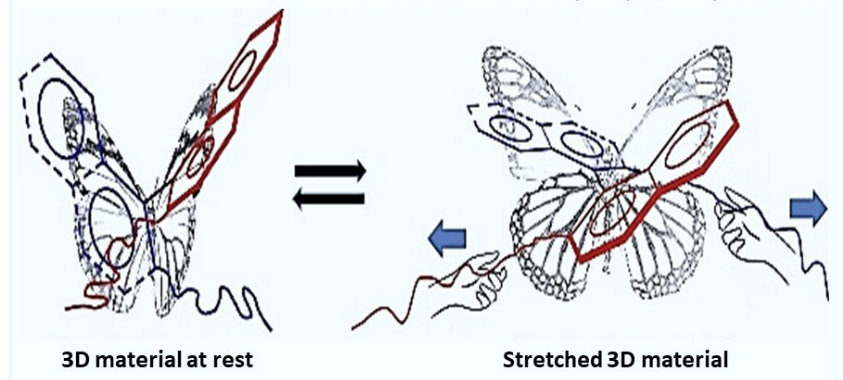
Mécanochimie réversible inspirée par la nature
Reversible soft-mechanochemistry inspired by nature
Amina Bensalah-Ledoux, Bruno Baguenard et Stéphan Guy (équipe MNP), en collaboration avec des collègues de Strasbourg ont publié un article intitulé "Reversible soft-mechanochemical control of biaryl conformations through crosslinking in a 3D macromolecular network" dans la revue Angewandte Chemie.
Amina Bensalah-Ledoux, Bruno Baguenard and Stéphan Guy (MNP group), with colleagues from Strasbourg published an article entitled "Reversible soft-mechanochemical control of biaryl conformations through crosslinking in a 3D macromolecular network" in the journal Angewandte Chemie.
Comme pour un papillon qui ouvre et ferme ses ailes, nous avons montré qu’il est possible de contrôler l’angle dièdre (DA) entre les deux “bras” d’une molécule chirale dérivée du BINOL. En effet, grâce au greffage de cette molécule au sein d'un réseau polymères 3D et en appliquant une force d'étirement mécanique macroscopique, un changement graduel contrôlé, de la conformation moléculaire du BINOL est obtenu et ce, de façon réversible et répétable. Cette mécano-transduction douce a été étudiée en utilisant des mesures spectroscopiques simples et efficaces des biréfringences et dichroïsmes optiques du matériau et a été corrélée avec des calculs de dynamique moléculaire. Ainsi, nous avons pu observer directement que l'étirement de l'élastomère entraine un élargissement de l’angle entre les deux naphtols de la molécule chirale. En combinant les résultats expérimentaux et théoriques, nous avons déterminé qu'une extension d'environ 170% de l’élastomère augmente l'ouverture de l’angle entre les deux bras de la molécule de 20°, via le transfert d'une force mécanique à la fraction BINOL de 2.5 kcal/(mol Å) (~175 pN).
Le contrôle de l’angle dièdre des composés axialement chiraux peut avoir un impact important sur l'activité biologique, l'efficacité catalytique, les performances de moteurs moléculaires ou les propriétés chiroptiques de ces matériaux.
Le contrôle de l’angle dièdre des composés axialement chiraux peut avoir un impact important sur l'activité biologique, l'efficacité catalytique, les performances de moteurs moléculaires ou les propriétés chiroptiques de ces matériaux.
As for a butterfly that opens and closes its wings, we have shown that it is possible to control the dihedral angle (DA) between the two “arms” of a chiral BINOL derived molecule. Indeed, by grafting this molecule within a 3D polymeric network and by the application of a macroscopic mechanical stretching force, a controlled gradual change in the molecular conformation of the BINOL is obtained in a reversible and repeatable manner. This soft mechano-transduction was studied using simple and efficient spectroscopic measurements of the optical birefringence and dichroisms of the material and was correlated with molecular dynamics calculations. Thus, we were able to directly observe that the stretching of the elastomer leads to a widening of the angle between both naphthyl rings when the BINOL is doubly-grafted to the elastomer network, while no effect was observed when only a single naphthyl ring is grafted. Combining the experimental and theoretical results, we have determined that ~170% extension of the elastomers led to the transfer of a mechanical force to the BINOL moiety of 2.5 kcal/(mol Å) (~175 pN) in magnitude and results in the opening of the BINOL DA up to 20°.
Tuning the dihedral angle of axially chiral compounds can impact biological activity, catalyst efficiency, molecular motor performance, or chiroptical properties.
Tuning the dihedral angle of axially chiral compounds can impact biological activity, catalyst efficiency, molecular motor performance, or chiroptical properties.


















